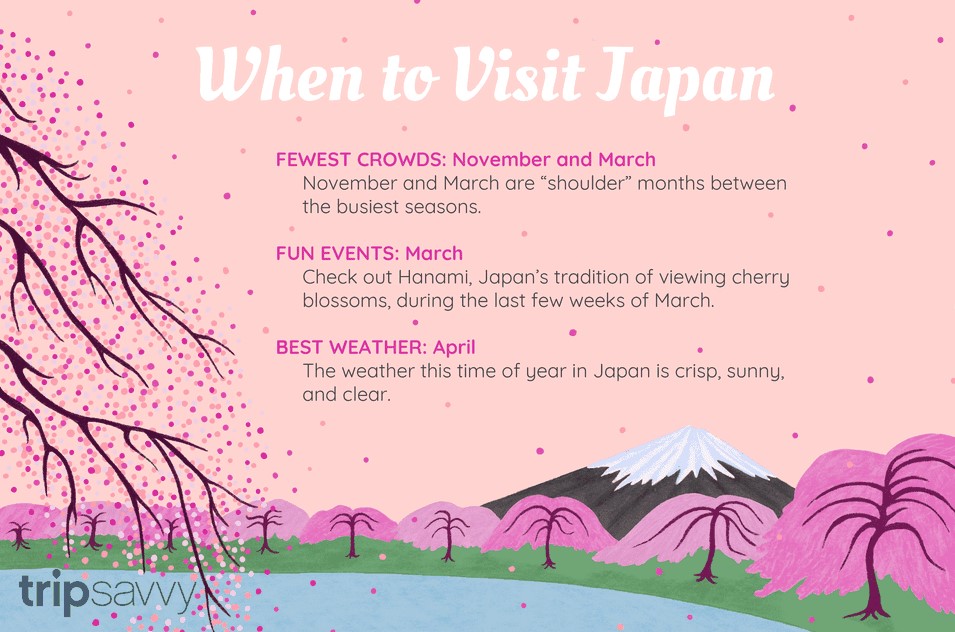The Best Times To Visit Japan
The Best Times To Visit Japan
Best Time To Visit Japan: A snowy getaway in Hokkaido, a beach vacation in Okinawa, or a photography trip to capture cherry blossoms in Tokyo — the best time to visit Japan depends entirely on what you want to do when you arrive.
As a country with a seemingly endless amount of activities and festivals on offer year-round, there really isn’t a bad time to visit. But if its shrine-hopping in Kyoto that brings you, or the pink hues of the cherry blossoms, you’ll want plan to make sure you don’t end up visiting during rainy season, or after all the blush pink cherry petals have already dropped.

Best Time Of Year To Visit Japan
Weather changes, typhoon season, and busy festivals should all be taken into account while deciding when to go to Japan. The best time to visit Japan is during early spring when the short-lived cherry blossoms are blooming but before or after the busy stretch of Golden Week holidays.
Although avoiding lousy weather is usually the goal of vacations, consecutive sunny days draw bigger crowds to East Asia. You’ll have to share transportation and attractions during high season. Hotels are already a bit pricey in Tokyo, but they skyrocket during some of Japan’s busiest festivals.
With an archipelago of close to 7,000 islands spread north to south in the Pacific, the weather in Japan can differ significantly between regions. Tokyo can be near freezing while people enjoy T-shirt weather just a little south.
Most of Japan enjoys four distinct seasons, with snow in the winter. However, Okinawa and the islands in the south stay warm throughout the year. Northern Japan often receives heavy snowfall that melts quickly in spring. Tokyo itself doesn’t ordinarily receive much snow. The megalopolis got a dusting in 1962, and then snow made headlines again in 2014 and 2016. In January 2018, a massive snowstorm caused disruptions in Tokyo.
When Is The Best Time To Visit Japan

Japan is on many a hotlist this year. Travel experts Lonely Planet have listed this country in their annual ‘Best in Travel’ list, and countless tour operators and holiday providers are predicting a huge increase in popularity for this Asian destination.
Research done in 2019 even showed that there has been a 700% increase in travellers purchasing Japanese Yen over the last year, according to ICE, the International Currency Exchange.
This is all very likely to do with the Rugby World Cup, which kicked off in September 2019, or the Olympic Games which will take place in summer 2020. But it’s likely also down to the increasing number of affordable flights now serving the region, coupled with its beguiling culture, stunning scenery and promise of the world’d best sushi.
Best Time To Visit Japan 2019
Japan is truly a year-round destination, and Japanese culture is remarkable in its profound appreciation of the changing of the seasons. As you’ll see when you visit, each season — and even sub-season! — is celebrated with seasonal foods, and often matsuri (festivals).
Because of all this, we typically recommend taking advantage of any chance to visit Japan.
On the other hand, if your dates are flexible it’s worth thinking about which time of year you’d enjoy most. After all, some travelers hate the cold — or the heat and humidity of summer — while others will do whatever it takes to avoid crowds! (When planning a trip to Japan, a key question to ask yourself is: would you rather have better weather, or fewer tourists around?)
The best time to visit Japan is generally considered to be between March and May, or October and November. However, it depends on your interests and what you’re planning to do during your trip. While many travelers prefer to avoid the heat and humidity of summer, or cold of winter, you might be an exception if you’re interested in summer matsuri (festivals) or winter onsen (hot springs), skiing, and snowboarding.
Best Time To Visit Japan For Cherry Blossoms
Japan has four distinct seasons: You’ve got the famed cherry blossoms in the spring, festivals in the summer, vibrant foliage in autumn, and powdery snow come wintertime.
In short, you’ll have the best chance of comfortable weather and fewer crowds in early spring (March – early April) and in autumn (late October – November). Our personal pick would be to visit Japan during November; but more on that later…
Let me back up… Truthfully there is no correct answer, as each season has its own unique draws (and drawbacks too). But we’re not going to just leave ya there, hangin’.
We’re going to go over the pros and cons of visiting Japan during each season to help you decide which time of year is ideal for YOU.
Answer these questions to get started:
-
Do you mind hot weather?
-
What about cold weather?
-
Are you easily bothered by crowds?
-
How much of your time do you want to spend outdoors?
-
Which would you rather see: cherry blossoms or colorful fall foliage?
Thinking about your answers to these questions is going to help you start to determine when to visit Japan.
While not a large country exactly, Japan spreads more than 1,800 miles (2,900+ kilometers) north to south, from the island of Hokkaido in the northeast all the way down to the island of Okinawa in the southwest.
A distance that large means the weather from north to south varies quite a lot. Hokkaido can be freezing while the subtropical island of Okinawa can be experiencing a beach day.
For the purpose of this article, we’ll mostly be discussing the weather on the island of Honshu. Located in the middle of the country, Honshu is where Tokyo, Osaka and Kyoto are all located, and is where most international travelers will start and end their trip, especially if it is your first time in Japan.
Another thing to take into consideration is that Japan is a very mountainous country. Common sense tells us that when you venture to higher elevations, you’ll find colder temperatures.
Best Time To Visit Japan 2017
For travelers determined to visit Japan during cherry blossom season, the dates of bloom depend on the weather conditions each year. From late March, trees in the warmer south begin to bloom, but in northern cities like Sapporo, don’t expect to see any pink until at least May. If you are staying between the Kansai and Kanto regions, the best time to see blossoms is either the last week of March or the first week of April.
Since weather significantly depends on which region you visit, bad weather in one area of Japan may mean clear skies in another. Rainy season typically runs from early June to mid-July throughout most of the country, except in Okinawa where showers begin in early May. Meanwhile, in Hokkaido, summertime brings mild temperatures and blue skies.
Because travelers all over the world admire Japan’s cherry blossoms, it shouldn’t be surprising that sakura season marks the busiest time for tourism. Domestic travelers take advantage of Golden Week (a national holiday in Japan), from the end of April to about mid-May. This means trains, hotels, and popular sightseeing spots can be overcrowded or entirely booked full.
And if crowds really aren’t your thing, you should note that Japan will host the Rugby World Cup in 2019 and the summer Olympics in 2020, so crowds will be at a high.
Another side effect of the upcoming Rugby World Cup and the Summer Olympics is that prices are about to skyrocket. Japan is already a pricier destination, and not popular with extremely frugal travelers — and the influx of crowds means you’ll be fighting with the masses for bargains on flights, hotels, and activities. Plan your trip for 2018 and aim for a winter visit to save the most money.
Best Time To Visit Japan 2018
The world will all be watching Japan this year as the Summer Olympic Games come to Tokyo. Set to begin with a dazzling opening ceremony on the 24th July 2020, there will be everything from the usual athletics and gymnastics to new sports, such as baseball and karate.
Tickets aren’t yet on sale for internationals, but if you’re looking to buy you can expect to spend between £40 and £2,000 depending on the event you choose. Visiting Japan during the Olympics will no doubt be an unforgettable experience, as the entire city will be celebrating sporting achievements.
Don’t have time to read the whole article? Here is a brief overview on different times of year in Japan, and their relative pros and cons:
- January (after the New Year’s holidays) and February can be great if you don’t mind the cold, because there are very few tourists.
- Late March and early April (cherry blossom season) are beautiful, but it’s one of the most crowded and expensive times of year.
- Mid to late May is great, with pleasant weather and not so many crowds.
- June can be nice, but is often rainy (and humid).
- July and August are very hot and humid, but also lively with lots of festivals.
- Mid to late September can be nice (if hot), with fewer tourists than summer or fall.
- October and November have very pleasant autumn weather, but also crowds rivaling spring (especially for the fall foliage in November).
Early December can be great if you don’t mind some cold, but mid to late December gets very crowded for New Year’s.
When should you avoid Japan?
When should I visit Japan in 2020?
What is the best month to travel to Japan?
